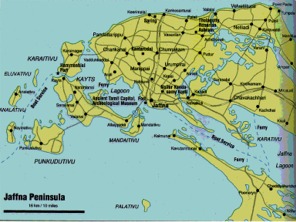AboutJaffna-
An Introduction

The Jaffna Peninsula
The Jaffna peninsula is practically an island, connected to the rest of Sri Lanka by a narrow split of land which houses the Chundikkulam bird sanctuary and a causeway known as Elephant Pass. Jaffna District is the northernmost region of Sri Lanka, and is populated by Tamil speaking people. Jaffna is low lying and shallow lagoons cover much of it and have a number of islands dotted offshore – Kayts, Karaitivu, Nainativu, Eluvaitivu, Analaitivu, Pungudutivu, Velanai, Mandativu and two uninhabited islands - Palaitivu and Kachaitivu.
The soil in the Jaffna Peninsula is harsh and arable only in some areas and the average temperature is approximately 28 to 30 C. Unlike the rest of fertile Sri Lanka, only hard work and forceful and continuous irrigation will bring a living out of this uninviting soil. Even with this handicap, the Tamils have created a cuisine that is so distinctive to their race. Tamils love their cuisine and pass it on to their children, so cooking methods stay close to different families. Families living in different areas in Jaffna Peninsula cook differently and each one has a distinct taste and flavour of their own. Mostly food is cooked from very fresh locally available produce and ingredients thus enhancing the taste. The weights and measures and methods of cooking remains in the hands of those who cook these meals and therefore, anyone who makes these dishes and everyone who will make these recipes will make some adjustments to suit their tastes and likings. However it is made though, no leftovers are generally found in any household.
In later stages, influence of other cultures like Malays, Indians and Muslims made remarkable changes in some methods of cooking and the type of meals the Jaffna people ate and some of these variations are also discussed where relevant. Tamils also live in other areas of Sri Lanka but this web site confines to meals and cooking in Yarlpanam for the reason that Jaffna meals have a very distinctive taste and flavour of their own.
Jaffna is famous for the deliciousness of its mangoes and toddy from the palmyrah palm. There are plenty of beaches but no resorts have ever been built. The palmyrah palm, a native of Sri Lanka and Southern India and of the Jaffna peninsula in particular, are hardy and stand straight, sending their roots deep to find water in unknown places. Palmyrah products are beneficial to mankind in many ways and is said to be the single most useful plant in the region. We will consider its usefulness in the Yarlpanam cuisine in this site. The palmyrah palm is a part of culinary culture of Jaffna people.
These recipes in these pages have been carefully compiled from recipes received from different families and most of them have been tried in the West by many. Care has been taken to give a fairly comprehensive selection, but the selection is not exhaustive. Weights and measures given are for guidance only and please make such adjustments to suit your taste and liking.
We dedicate this site to the future generations of Yarlpanam, living abroad, who will want to taste their family cuisine and keep their traditions. Almost all the ingredients are available in most Asian groceries specialising in Sri Lankan and Indian produce in Australia, Europe, United States, Canada and other major cities. We have suggested suitable alternatives where necessary.
We hope you will enjoy Yarlpanam cooking as much as we do and keep the tradition with you.
Related articles Please read: Early Yarlpanam, Yarlpanam Today





